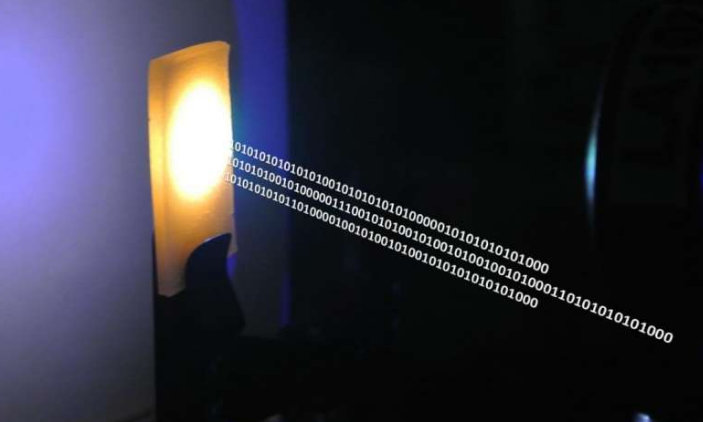Communication technologies such as Wi-Fi and Bluetooth operate on invisible radio waves, but it turns out, transmitting data on wavelengths we can see may be more efficient and secure. A team of researchers at King Abdullah University of Science and Technology (KAUST) in Saudi Arabia developed a nanocrystal that helps boost data speeds transmitted through a visible light LED up to 2 Gbps while also lighting up the room.

A nanocrystal-based material can convert blue laser emission to white light for combined illumination and data communication. Source: KAUST.
Because just a fraction of the electromagnetic spectrum can be seen by the human eye, making use of those wavelengths could mean faster and safer wireless data systems. With so many wireless signals zipping around, certain frequencies can become clogged, and radio waves can interfere with sensitive equipment, such as those used for navigation or in hospitals. Visible-light communication (VLC) systems can help bypass these issues.
Currently, VLC devices are based on LEDs, which use phosphorus to turn some of the blue light emitted by a diode into green and red. When combined, the colors form white light to comfortably light a room while also providing a wireless signal. But as you’re likely aware, this technique comes with limits.
“VLC using white light generated in this way is limited to about one hundred million bits per second,” said KAUST Professor of Electrical Engineering, Boon Ooi. However, a University of Virginia study reached 300 Mbps, and Siemens managed 500 Mbps. Pennsylvania State University has even hit 1.6 Gbps using invisible infrared light.
As for the researchers at KAUST, they’ve achieved 2 Gbps using visible light, converting the colored light into white using nanocrystals instead of phosphorus. At 8 nm long, the crystals are made of cesium lead bromide and, when hit by a blue laser, emit green light. An incorporated nitride phosphor emits red light, and the three colors combine to form the white, room-illuminating light that's comparable to that of existing LEDs.
In nanocrystals, the optical processes operate on a time-scale of about seven nanoseconds, meaning the optical emission of the light operates at a frequency of 491 MHz. This allows the data to be transmitted at 2 Gbps. Data is transferred through a series of flashes, undetected by the human eye, but clear to a receiving sensor.
The research was originally published in the journal ACS Photonics.
Advertisement
Learn more about Electronic Products Magazine





